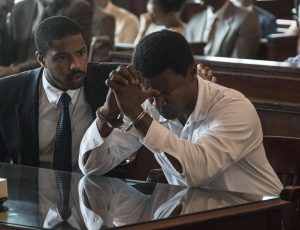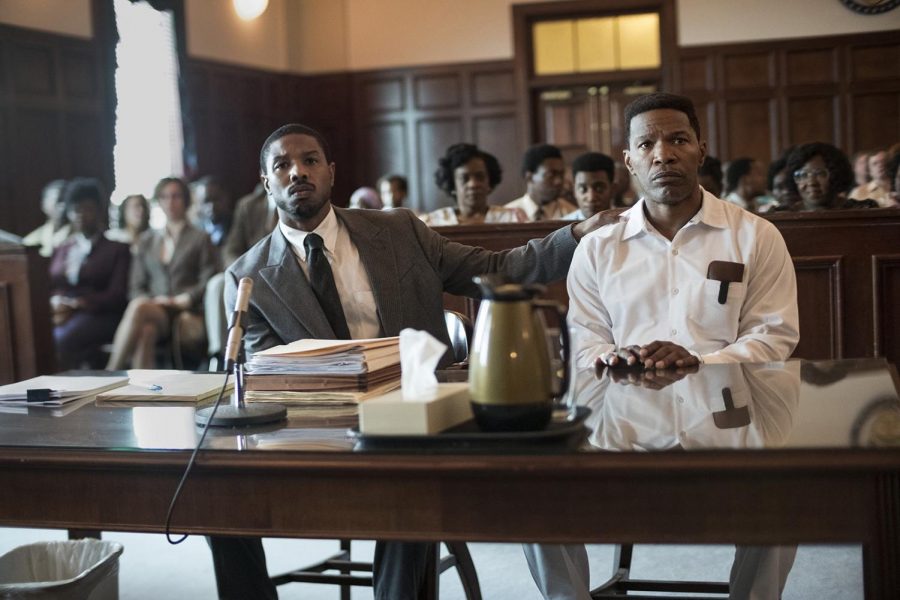Mercy in the Face of Injustice
Just Mercy gracefully honors Bryan Stevenson’s best selling memoir while illustrating his fight for mercy in a corrupt criminal justice system.
PHOTO | MCT Campus
Michael B. Jordan (left) and Jamie Foxx in “Just Mercy.” (Warner Brothers Pictures/TNS)
“Mercy is just when it is rooted in hopefulness and freely given,” activist lawyer Bryan Stevenson wrote in his New York Times Bestselling memoir “Just Mercy.”
Adapted to film by director Destin Daniel Cretton, “Just Mercy,” premiered Dec. 25, portrays one man’s resilient fight for justice in the face of systemic oppression. With “Creed” actor Michael B. Jordan taking the lead role of Stevenson and Academy award-winning actor Jamie Foxx playing wrongfully convicted Walter “Johnny D” McMillian, the film captures a raw depiction of this empowering story of justice, redemption and mercy.
“Just Mercy” challenges and teaches based on the faults that lie within the United States’ criminal justice system. The film follows the journey of a young Stevenson as he builds up his legal practice, Equal Justice Initiative, in Alabama. Taking on cases dealing with the poor and underprivileged, Stevenson encounters wrongfully convicted McMillian, a black man on death row for a murder he couldn’t have possibly committed. Through showcasing the intertwined lives and stories surrounding McMillian’s case, the film reveals authentically and beautifully the true definition of justice and mercy in a society ridden with hate.
“Just Mercy” thrives by the light the actors instill into their characters. With a star-studded cast consisting of Jordan, Foxx, Academy award-winner Brie Larson and rapper Ice Cube’s son Oshea Jackson Jr., the film is upheld by their remarkable portrayals. Each cast member proved to be a spitting image of their real-life counterparts.

From left: Bryan Stevenson (Michael B. Jordan) and Walter McMillian (Jamie Foxx) in “Just Mercy” [Warner Bros. Pictures)]
However, the greatest moments of the film are the scenes shared between Jordan and Foxx. The chemistry between the two radiated off the screen. In these intimate moments between Stevenson and McMillian, Jordan and Foxx deliver an outstanding performance in which they elegantly communicate the intense bond between the two characters. As they share in pain, racism and hope, Jordan and Fox translate these emotions so clearly through the screen.
In comparison to the book, the film takes all of the essential components of Stevenson’s 300-page memoir and condenses it into a refined two-hour film, all while maintaining Stevenson’s voice and message. The most notable difference between the film and the book is the role of EJI operations director Eva Ansley, played by Larson. Though an important character in the novel, her interactions with Stevenson heavily increased in the film. This change was key as it allowed for her to serve as a soundboard to the many thoughts Stevenson had narratively expressed throughout the memoir.
Earning an NAACP Image Award nomination for outstanding motion picture, “Just Mercy” is a film that is both powerful and needed. This adaptation passionately stays true to the book and the factuality of the events while offering its own artistic touches. “Just Mercy” is a must-see film in a society in dire need of justice.
As required reading for juniors in English teacher Casey Engel’s advanced placement English language and composition class, the school partnered with Rockhurst High School and St. Teresa’s Academy to offer a free screening of the film Feb. 4 at the AMC Theater in Ward Parkway.
As seen in issue 4 here.



